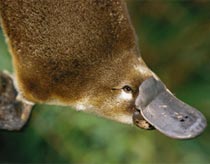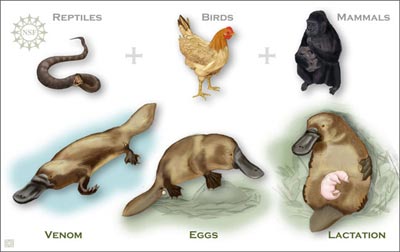Duckbill - the most exotic creature in the world
The platypus has a mammal-like fur, its waddling legs are like birds and lay eggs in the style of reptiles.

The duckling otter.(Photo: sciencecentric)
The natural mother molded and turned them into a strange hybrid creature. Researchers have completed the genetic mapping of a female speculum from Australia.
"The platypus is a very old branch in the zoo, so, about 166 million years ago, we shared a common ancestor with a speculum," said researcher Jenny Graves of the Australian National University. "And that puts them in the middle of two groups of mammals and reptiles, because they still hold a lot of reptilian properties that we have lost for a long time, such as egg laying."
"We can rely on this creature to follow human changes when moving from reptile to growing hair, producing milk and giving birth."
This ancient animal lives in caves in eastern Australia, searching for food along rivers and streams. Its flattened body is about 50 cm wide with a paddle-like tail and 4 webbed feet. The platypus is one of only two mammal species (the other is the porcupine) that lays eggs . And unlike other mammals, male ducklings can secrete venom from a small spindle on each hind leg.
To understand the evolutionary link between the duckling otter and other animals, the researchers compared the genetic map of a female speculum to humans, mice, dogs, opossum and chickens. .

Duck-billed otters are a patchwork of reptiles, birds and mammals.(Photo: Livescience)
With about 2.2 billion pairs, the platypus genome is about two-thirds the size of the human genome. It shares 80% of genes with other animal species.
Like humans, the platypus carries the X and Y chromosomes. But unlike us, X and Y are not sex chromosomes. This animal has 52 chromosomes, including 10 sex chromosomes. The genome also includes DNA fragments involved in egg production and lactation. Because there are no nipples, the babies are breastfed through the abdomen.
Another odd thing is that when swimming in the water, the platypus aims at the eyes, ears and nose again. Then the speculum acts as an antenna, detecting the weak magnetic field around the prey. Even so, their genome shows that they still have genes for odor detection.
The study includes more than 100 scientists worldwide and is funded by Australia's National Human Genome Research Institute.
- Mysterious decoding 60 years of life
- Discover the most 'weird' duckbill dinosaur in history
- Not an alien, this is the most exotic giant bug on Earth
- Find fossil tracks of 3 duckbill dinosaurs
- Discovered a giant 8-meter alien ink
- Top 10 weird animals in the world
- Listed 12 most exotic towns in the world
- Pig monster has an odd appearance in Indonesia
- Biologists discovered mysterious sea larvae
- The creature 'stunningly beautiful' makes the scientific world a headache
- The 'monster' species grows back to its head, turning prey into water
- Detecting strange creatures in the sea 1.300m deep
 Animal 'suffering' after hibernation
Animal 'suffering' after hibernation Why do goats climb well?
Why do goats climb well? Scientists were surprised to see chimpanzees eating turtles
Scientists were surprised to see chimpanzees eating turtles Giant catfish died deadly due to drought in Thailand
Giant catfish died deadly due to drought in Thailand